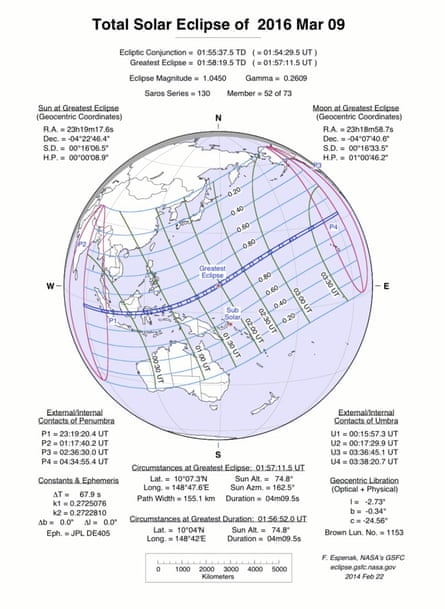Day will turn to night this week for millions of people, as the moon passes directly in front of the sun causing a total solar eclipse.
On Wednesday 9 March, people in some parts of Australia and south-east Asia will be able to witness the event. It will also be visible in Hawaii, east of the international dateline, where it will still be Tuesday 8 March. For those further west or east in Europe and America, it will already be night, so the sun will not be visible.
Here’s what you need to know.
What is a solar eclipse?
A solar eclipse occurs when the moon passes directly between the Earth and the sun, casting a shadow over the Earth. It can only happen during a new moon – when the dark side of the moon is facing the Earth.
Lunar eclipses, on the other hand, occur when the Earth passes between the sun and the Moon, casting a shadow over a full moon.
Where and when to see the eclipse
The following graphic produced by Nasa shows from where you can best see the eclipse.
As the Earth rotates, the best spot to see the eclipse will move along the the central blue zone. If you’re lucky enough to be in that zone – most of which lies in Indonesia – then you should be able to see the sun completely blocked by the moon.

If you are a long way north or south of that spot, you will only be able to see a partial eclipse. For example, people in Darwin in northern Australia will be able to see 60% of the sun covered by the moon. People in Perth should be able to see 10% of the sun blocked.
Moving north, people in southern Vietnam and Thailand will see a 60% eclipse, while most people in Japan should be able to see a 20% eclipse.
Wondering where you can see the eclipse from next Tuesday? This gif that NASA made should have you covered. pic.twitter.com/xWYbHVyWZf
— Michael Slezak (@MikeySlezak) March 3, 2016
If you’re confused by the times (and date) in those graphics, don’t worry – the eclipse won’t be happening at midnight. The time there is Universal Time, which is equivalent to Greenwich Mean Time. You can use Google or a site like this to convert it to your local time.
In Australia, unfortunately the major centres of Sydney, Brisbane, Adelaide and Hobart will miss out on the eclipse. But if you’re in Queensland, and north of about Rockhampton, you should be able to see a partial eclipse from about 11am on the coast, or a bit earlier from inland.
In the Northern Territory, it should happen around 10am. And most people in Western Australia should be able to see a partial eclipse – start watching from about 8am.
In central Sumatra in Indonesia, where the eclipse will be a total one, it will happen almost immediately after the sun rises, so start watching from about 6.30am. In Jakarta, you should see about a 90% eclipse about 15 minutes later.
In Japan, you should be able to see about a 20% eclipse. It will start at about 10.20am in the west.
In Hawaii, if the skies are clear, you should be able to see a 60% eclipse from about 5.30pm, just as the sun is preparing to set.
Here are some guides for key centres along the route of the eclipse. The following places will experience totality at these times (all times local):
- Palembang, Sumatra: 7.21am
- Palu, Sulawesi: 8.38am
- Ternate, Malaku: 9.53am
And these cities will also see their peak partial eclipse at the following (local) times:
- Bangkok, Thailand: 7.32am
- Singapore: 8.23am
- Kuala Lumpur, Malaysia: 8.23am
- Manila, Philippines: 8.58am
- Darwin, Australia: 10.17am
- Cairns, Australia: 11.12am
The total eclipse viewing time will span an hour either side of these times.
Wherever you are, pop by the Guardian website and follow our stories, which will be collecting photographs of the event as it happens.
The most important thing
Do not look directly at the sun.
The eclipse itself can be viewed safely with the naked eye for only a few seconds, and only if you are in a location where the sun will be completely covered by the moon.
Looking at even a sliver of the sun can cause permanent eye damage or blindness.
And your sunglasses don’t help either. Read on to find out the safest way to watch.
How to watch the eclipse
As we warned above, do not look directly at the sun – but there are some materials you can use to safely look at the sun. You could buy some “number 14 welder’s glass” from a welding supply outlet or from some hardware stores. You can also use aluminized mylar, which can even be cut with scissors.
Another way to see it happen is to make your own pinhole camera. Basically, it requires poking a hole in a box, and putting some paper over the back of it. Follow directions in this video:
How often do eclipses occur?
Solar eclipses can occur up to five times a year, although that is rare. Nasa keeps a list of past and future eclipses and according to that, only 25 years in the past 5,000 have had five solar eclipses.
Each eclipse is viewable from a different location. For example, in 2015 a total eclipse of the sun was viewable from the UK, but that country won’t see another one until 2090.
Comments (…)
Sign in or create your Guardian account to join the discussion